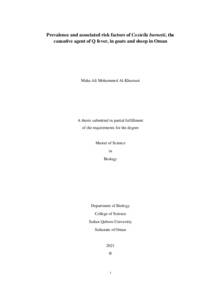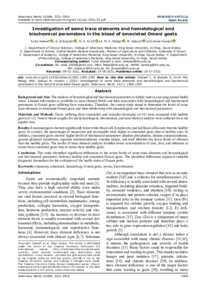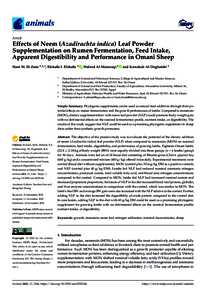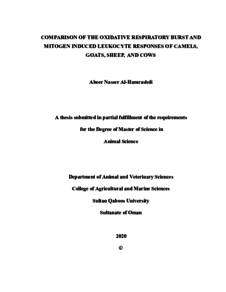Document
Prevalence and associated risk factors of Coxiella burnetii, the causative agent of Q fever, in goats and sheep in Oman.
Other titles
انتشار الكوكسيال بورنيتية-العامل المسبب لحمى كيو-وعوامل الخطر المرتبطة بها في الماعز والأغنام في سلطنة عمان
Publisher
Sultan Qaboos University.
Gregorian
2021
Language
English
English abstract
This cross-sectional study is the first large-scale study on the detection of Q fever to
offer an inclusive understanding of the C. burnetii epidemiology among the goats and
sheep species in Oman, using serological and molecular techniques. Q fever is a
zoonotic and widespread disease caused by Coxiella burnetii, a short gram-negative,
coccobacillus that is highly infectious and resistant to harsh environmental conditions.
C. burnetii exhibits a variety of antigenic phases, Phase I and Phase II. C. burnetii can
infect humans and a wide range of animal species. Nevertheless, goats, sheep, and
cattle are the main reservoirs for human outbreaks, and inhalation of contaminated
aerosols or dust is the primary source of human infection. The clinical presentation of
Q fever differs depending on the species of host. In human and animals, they are
mainly asymptomatic except for pregnant ruminants in which reproductive disorders
can occur. The aims of the current study were to estimate the seroprevalence of Q
fever antibodies and identify the potential risk factors associated with Q fever
seropositivity in goats and sheep in the Sultanate of Oman. In addition, evaluate the
presence of C. burnetti DNA in blood samples from goats and sheep. The cross sectional study was conducted in the seven governorates of Oman. Enzyme-linked
immunosorbent assay (ELISA) was used for screening C. burnetti antibodies in
496 serum samples of goats and sheep and nested-polymerase chain reaction (Nested PCR) was used for detecting C. burnetti DNA in 180 blood samples. Statistical
analysis was performed using the chi-squared test, binary logistic regression,
McNemar test, and Cohen's kappa test. The overall seroprevalence of Q fever was
45.77%. Q fever seropositivity in goats and sheep was significantly associated with
location, age, sex, and recent history of abortion. The highest seroprevalence was in
Ash Sharqiyah (66.96%), and the lowest was in Dhofar (2.08%). The finding indicates
that Q fever seropositivity was higher in goats and sheep ≥ 2 years than ˂ 2 years.
Further, it was found that Q fever seropositivity was higher in female goats (58.5%)
and female sheep (42.25%) than in male goats (30.14%) and male sheep (21.15%).
Females were 3.1 times more likely to exhibit Q fever illness than males (95% CI:
1.95–5.02; P < 0.05). Out of 496 samples screened for Q fever antibodies, 156
(51.65%) and 71 (36.59%) tested positive for goats and sheep, respectively. The
seroprevalence of Q fever in goats and sheep that had a recent history of abortion was
72.13% and 60% respectively. Goats and sheep with a recent history of abortion were
5.1 times more likely to be C. burnetii seropositive compared to healthy animals (95%
CI: 3.41–7.48; P < 0.02). The overall molecular prevalence in the study area was
17.78% (95% CI: 12.49%-24.16%). The highest active infection revealed by the PCR
was in Ash Sharqiyah (39.70%). There was a poor agreement between ELISA and
nested-PCR (kappa value = 0.183). In addition, the McNemar test results shown that
ELISA and PCR tests provided significantly different outcomes (p < 0.05). The results
of the current study showed that the Q fever in Oman is widely spread. Further studies
on C. burnetii infection and genotyping are recommended.
Member of
Resource URL
Arabic abstract
تعد هذه الدراسة هي أول بحث واسع النطاق للكشف عن مرض حمى كيو في الماعز والأغنام في سلطنة عمان ، باستخدام التقينات المصلية والجزيئية ، إن حمى كيو هي مرض مشترك واسع الانتشار تسببه بكتريا Coxiella burnetii
Category
Theses and Dissertations




